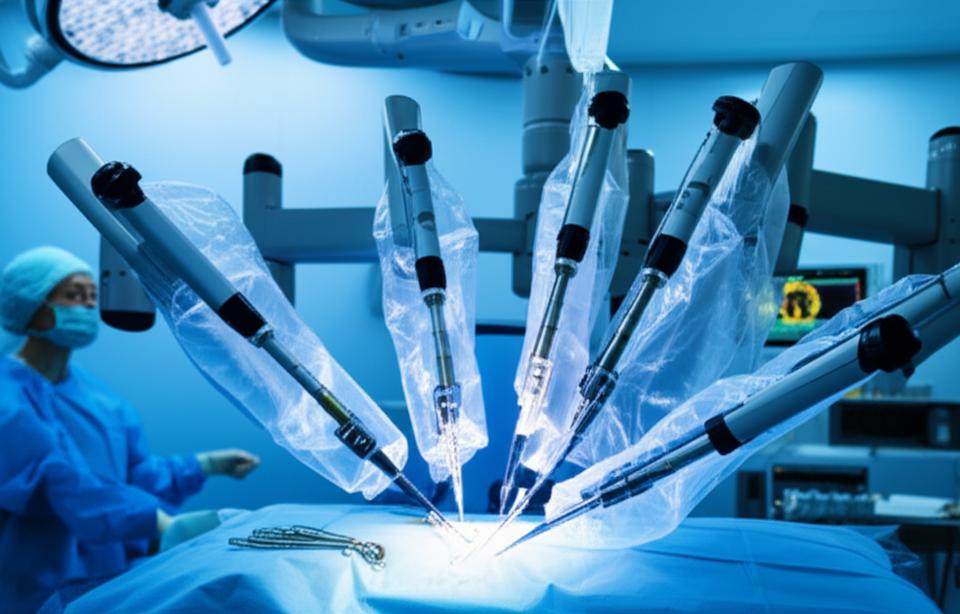Medical Robots: Revolutionizing Healthcare

Medical Robots: A Revolution in Healthcare
Nội dung
- 1 Medical Robots: A Revolution in Healthcare
- 1.1 What are Medical Robots?
- 1.2 Who Uses Medical Robots?
- 1.3 When are Medical Robots Used?
- 1.4 Where are Medical Robots Used?
- 1.5 Why Use Medical Robots?
- 1.6 How Do Medical Robots Work?
- 1.7 Types of Medical Robots
- 1.8 Examples of Medical Robots
- 1.9 The Future of Medical Robots
- 1.10 Potential Challenges and Concerns
- 1.11 Conclusion
- 1.12 Chia sẻ:
- 1.13 Thích điều này:
Medical robots are transforming the healthcare industry, offering enhanced precision, efficiency, and safety in various medical procedures. From assisting surgeons in complex operations to aiding patients in rehabilitation, these advanced machines are reshaping how healthcare is delivered.
What are Medical Robots?
Medical robots are sophisticated machines designed to assist healthcare professionals in performing a wide range of tasks. These robots are equipped with advanced sensors, cameras, and software that allow them to perform complex maneuvers with greater accuracy and control than humanly possible.
Who Uses Medical Robots?
Medical robots are used by a variety of healthcare professionals, including surgeons, therapists, and nurses. They are employed in hospitals, clinics, and rehabilitation centers worldwide.
When are Medical Robots Used?
Medical robots are utilized in a variety of scenarios, including:
- Surgery: Assisting surgeons in performing minimally invasive surgeries, reducing recovery times and improving patient outcomes.
- Rehabilitation: Helping patients regain mobility and strength through repetitive exercises and personalized therapy programs.
- Drug Delivery: Precisely delivering medication to targeted areas within the body, minimizing side effects and maximizing effectiveness.
- Diagnostics: Assisting in performing biopsies and other diagnostic procedures with greater accuracy and speed.
- Disinfection: Cleaning and disinfecting hospital rooms and equipment to prevent the spread of infections.
Where are Medical Robots Used?
Medical robots are used in a variety of healthcare settings, including:
- Hospitals
- Clinics
- Rehabilitation Centers
- Research Laboratories
Why Use Medical Robots?
The use of medical robots offers numerous benefits, including:
- Increased Precision: Robots can perform tasks with greater accuracy and control than humans, leading to improved outcomes.
- Reduced Invasiveness: Minimally invasive surgery using robots results in smaller incisions, less pain, and faster recovery times.
- Enhanced Efficiency: Robots can perform tasks faster and more efficiently than humans, reducing the overall cost of healthcare.
- Improved Safety: Robots can reduce the risk of human error and infection, leading to a safer environment for patients and healthcare professionals.
- Remote Capabilities: Some robots can be controlled remotely, allowing surgeons to perform procedures from anywhere in the world. This is particularly useful in areas with limited access to specialized medical care. Telemedicine and remote surgery are increasingly reliant on robotic systems.
How Do Medical Robots Work?
Medical robots work by combining advanced hardware and software. They typically consist of:
- Robotic Arms: These arms are equipped with specialized tools that allow them to perform various tasks.
- Cameras and Sensors: These provide the surgeon or therapist with a detailed view of the surgical site or the patient’s movements.
- Control System: This allows the healthcare professional to control the robot’s movements and actions.
- Software: Sophisticated algorithms and software programs guide the robot’s movements and ensure accuracy and safety.
Types of Medical Robots
There are several types of medical robots, each designed for specific applications:
- Surgical Robots: These robots assist surgeons in performing complex procedures, such as heart surgery, prostatectomies, and hysterectomies. The da Vinci Surgical System is a well-known example.
- Rehabilitation Robots: These robots help patients regain mobility and strength after a stroke, spinal cord injury, or other debilitating conditions. Examples include Lokomat and robotic exoskeletons.
- Drug Delivery Robots: These robots deliver medication to targeted areas within the body, such as cancerous tumors.
- Diagnostic Robots: These robots assist in performing biopsies and other diagnostic procedures with greater accuracy and speed.
- Disinfection Robots: These robots use ultraviolet light or other methods to disinfect hospital rooms and equipment.
- Telepresence Robots: These robots allow doctors to remotely interact with patients and staff in different locations. They are equipped with cameras, microphones, and speakers, enabling real-time communication and examination.
Examples of Medical Robots
- da Vinci Surgical System: A surgical robot used for minimally invasive surgery. More information can be found on the Intuitive Surgical website: https://www.intuitive.com/en-us/products-and-services/da-vinci
- Lokomat: A rehabilitation robot used to help patients with gait training. More information can be found on Hocoma’s website: https://www.hocoma.com/solutions/lokomat/
- Auris Health Monarch Platform: Used for bronchoscopy procedures, allowing doctors to navigate and access small, hard-to-reach areas of the lungs. More information can be found on Auris Health (now part of Johnson & Johnson):
https://www.jnjmedtech.com/en-US/product/monarch-platform
The Future of Medical Robots
The field of medical robotics is rapidly evolving, with new technologies and applications emerging constantly. Some future trends include:
- Artificial Intelligence (AI): AI is being integrated into medical robots to improve their ability to learn, adapt, and make decisions autonomously. This will lead to more sophisticated and personalized treatments.
- Nanobots: These tiny robots could be injected into the body to diagnose and treat diseases at the cellular level. This is still in the early stages of development, but holds immense potential.
- Haptic Feedback: This technology allows surgeons to feel the tissues and organs they are operating on, providing a more realistic and intuitive surgical experience.
- Cloud Robotics: Connecting medical robots to the cloud will enable them to share data and learn from each other, leading to faster innovation and improved performance.
Potential Challenges and Concerns
While medical robots offer numerous benefits, there are also some challenges and concerns that need to be addressed:
- Cost: Medical robots can be expensive to purchase and maintain, which may limit their availability in some healthcare settings.
- Training: Healthcare professionals need to be properly trained to use medical robots effectively and safely.
- Ethical Concerns: As medical robots become more autonomous, ethical concerns arise about their decision-making capabilities and the potential for bias.
- Cybersecurity: Medical robots are vulnerable to cyberattacks, which could compromise patient safety and data privacy.
Conclusion
Medical robots are revolutionizing healthcare, offering enhanced precision, efficiency, and safety in a wide range of medical procedures. As technology continues to advance, medical robots will play an increasingly important role in improving patient outcomes and transforming the future of healthcare.
While considering advanced medical technologies, remember that efficient business operations are also crucial for healthcare providers. Consider exploring software solutions like Ebiz to streamline administrative tasks, manage inventory, and improve overall efficiency. While Ebiz may not directly integrate with medical robots, it provides a robust platform for managing the business side of healthcare, allowing medical professionals to focus on patient care and advanced medical technologies.
Ebiz is a popular software solution for businesses. You can find out more about its features and benefits by visiting their website:
https://www.phanmempos.com/cua-hang

